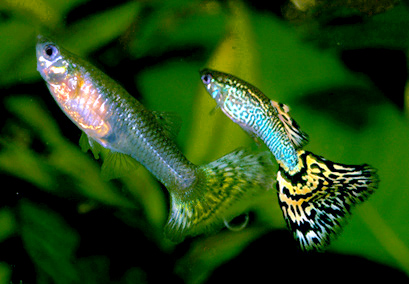(guppy) |
m (Googla moved page Guppy to FishWiki:Guppy: guppy) |
||
| (One intermediate revision by the same user not shown) | |||
| Line 1: | Line 1: | ||
The guppy (Poecilia reticulata), also known as '''millionfish''' or the '''rainbow fish,'''<ref>guppy</ref> is one of the world's most widely distributed tropical fish and one of the most popular freshwater aquarium fish species. It is a member of the family Poeciliidae and, like almost all American members of the family, is live-bearing.<ref>guppy</ref> Guppies originate from northeast South America, but have been introduced to many environments and are now found all over the world. they are highly adaptable and thrive in many different environmental and ecological conditions.<ref>guppy</ref> Male guppies, which are smaller than females, have ornamental caudal and dorsal fins. Wild guppies generally feed on a variety of food sources, including benthic algae and aquatic insect larvae.<ref>guppy</ref> Guppies are used as a model organism in the fields of ecology, evolution, and behavioural studies.<ref>guppy</ref> | The guppy (Poecilia reticulata), also known as '''millionfish''' or the '''rainbow fish,'''<ref>guppy</ref> is one of the world's most widely distributed tropical fish and one of the most popular freshwater aquarium fish species. It is a member of the family Poeciliidae and, like almost all American members of the family, is live-bearing.<ref>guppy</ref> Guppies originate from northeast South America, but have been introduced to many environments and are now found all over the world. they are highly adaptable and thrive in many different environmental and ecological conditions.<ref>guppy</ref> Male guppies, which are smaller than females, have ornamental caudal and dorsal fins. Wild guppies generally feed on a variety of food sources, including benthic algae and aquatic insect larvae.<ref>guppy</ref> Guppies are used as a model organism in the fields of ecology, evolution, and behavioural studies.<ref>guppy</ref> | ||
[[File:Guppy coppia gialla.jpg|thumb|guppy male with female]] | |||
==guppy sizes== | ==guppy sizes== | ||
Guppies vary in size depending on their gender. Male guppies are typically 1.5–4 cm (0.6–1.6 in) long, while female guppies are generally 3–7 cm (1.2–2.8 in) long.<ref>guppy</ref> | Guppies vary in size depending on their gender. Male guppies are typically 1.5–4 cm (0.6–1.6 in) long, while female guppies are generally 3–7 cm (1.2–2.8 in) long.<ref>guppy</ref> | ||
Latest revision as of 12:40, 21 September 2024
The guppy (Poecilia reticulata), also known as millionfish or the rainbow fish,[1] is one of the world's most widely distributed tropical fish and one of the most popular freshwater aquarium fish species. It is a member of the family Poeciliidae and, like almost all American members of the family, is live-bearing.[2] Guppies originate from northeast South America, but have been introduced to many environments and are now found all over the world. they are highly adaptable and thrive in many different environmental and ecological conditions.[3] Male guppies, which are smaller than females, have ornamental caudal and dorsal fins. Wild guppies generally feed on a variety of food sources, including benthic algae and aquatic insect larvae.[4] Guppies are used as a model organism in the fields of ecology, evolution, and behavioural studies.[5]

guppy sizes
Guppies vary in size depending on their gender. Male guppies are typically 1.5–4 cm (0.6–1.6 in) long, while female guppies are generally 3–7 cm (1.2–2.8 in) long.[6]